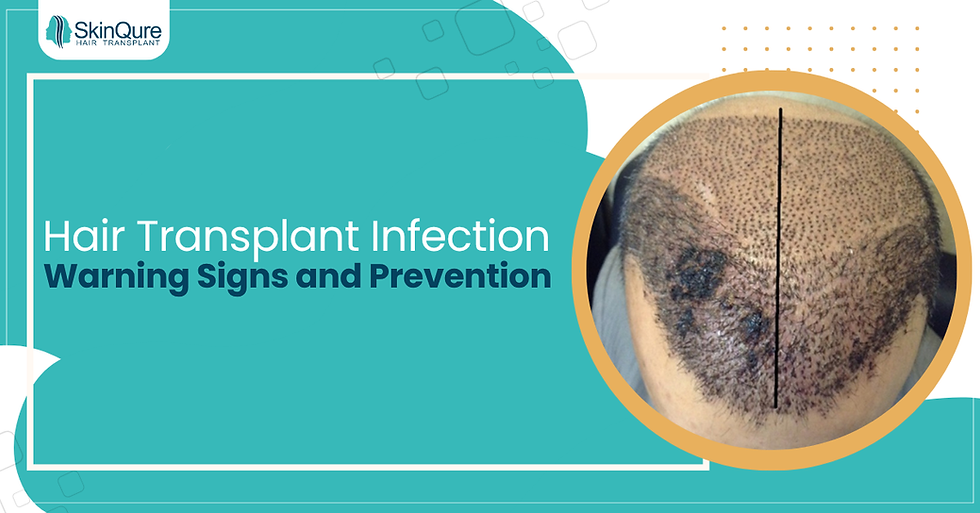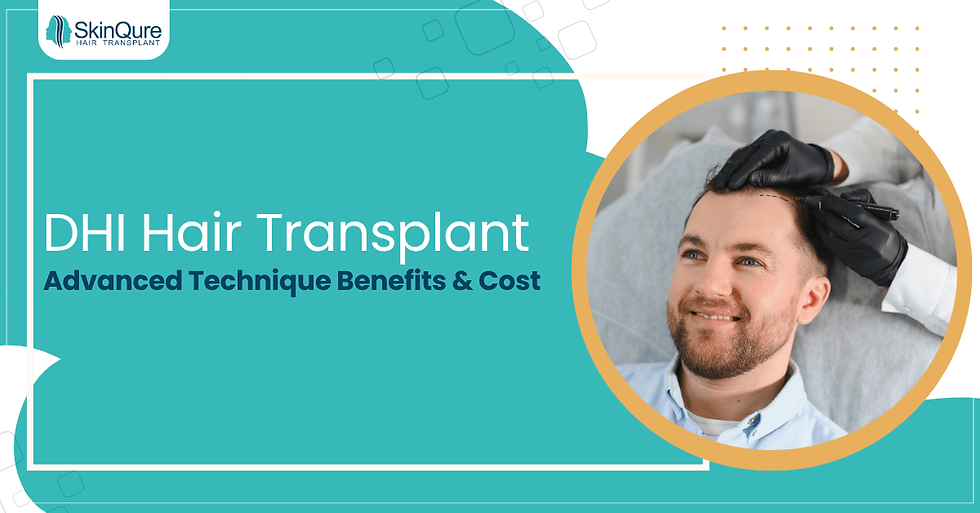Hair Transplant Infection: Warning Signs and Prevention
- Dr Jangid, MD
- Oct 1
- 5 min read

Hair transplantation is now a reliable option for individuals facing baldness or balding hair. Although techniques such as FUE and FUT are modern and yield natural-looking outcomes, patients should also be made aware of potential risks. Perhaps the most worrying risk is a hair transplant infection. Identification of symptoms at an early stage and taking appropriate measures avoids dangerous consequences. This blog explores the signs, causes, and effective measures for preventing hair transplant infection.
Hair loss is becoming a common issue for both men and women. Many have found new hope with a hair transplant that provides permanent and natural-looking outcomes. Just like other treatments, it also causes post surgery complications, and risks.
post surgery complications may cause a delay in healing, compromise the survival of the graft, and in others, result in scarring or bad outcomes. Patients are often not well-versed in understanding the causes of infection, early signs to recognize, and the best ways to prevent infection. At SkinQure Dr Jangid provides post-operative care since most complications that arise after surgery can be prevented with proper advice. A successful transplant is not only the procedure itself but also how well patients manage healing.
Did you know?
Minor hair transplant infection affects less than 1% of patients when hygiene after surgery is practiced.
Ignoring subtle signs of redness can advance into post surgery complications within a few days.
Following simple measures of infection prevention like hand washing prior to handling the scalp can halve the risks.
Smoking has been claimed to prevent healing and make patients susceptible to hair transplant infection by surgeons.
What is hair transplant infection?
Hair transplant infection usually occurs when harmful bacteria enter the operating area. The scalp is pierced into tiny cuts through which follicles are implanted and healing is sensitive. The germs build up if these areas are not cleaned regularly.
The majority of the infections are superficial and can be cured. Severe infections can, however, ruin grafts permanently. It is for this reason that patients should keep track of healing and go see doctors when they experience unexplainable symptoms. Proper early diagnosis prevents permanent damage and ensures that your transplant stays stable.
Causes of hair transplant infection
The hair transplant infection that can be caused by a hair transplant can be initiated by a variety of factors. In most cases, improper sterilization of the equipment during surgery may be at issue, but this is an uncommon event at reputable centers. Quite often, it is due to patient post-operative negligence.
Hair transplant infection can also be caused due to poor hygiene, touching the scalp often, and the use of local lotions and oils. Hyper hydrolysis patients, smokers, and patients not following the post-operative care are majorly at risk. In some cases, pre-existing health conditions like diabetes can lead to post surgery complications.
How to prevent hair transplant infection?
It is crucial to identify early signs of hair transplant infection. Infections can be found in the form of redness, pain, swelling, and drainage of pus. The scalp may feel warm upon palpation, and fever may be experienced in some cases.
When symptoms do occur, the patient should inform their surgeon. If left untreated, these can lead to severe post surgery complications, such as the loss of follicles. Prompt medical care ensures the infection is resolved before it becomes more complicated.
Do keep in mind that minor pain is a usual outcome of surgery. But increasing pain or unusual discharge must never be disregarded. Early recognition and employing suggested infection prevention protocols could possibly spare health and outcomes.
Post-surgery complications due to infection
If left untreated, a hair transplant infection can lead to many issues. Such post surgery complications are scarring, delayed healing, and even failure of grafts transplanted. In extreme circumstances, severe infection can spread beyond the scalp and necessitate stronger treatment.
The patient spends time, money, and trust on his procedure, so safeguarding the result is important. Preventative habits, personal cleanliness, and medical advice facilitate healing. Do not forget that prevention always precedes the management of late complications. That is why physicians especially stress strict infection prevention protocols prior to discharge of patients.
How to take care of hair transplant infection?
Prevention is the best option for an infection in a hair transplant. Doctors provide careful aftercare instructions that must be followed strictly. Light washing of the scalp with prescribed solutions, avoiding scratching, and avoiding wearing close-fitting caps during the recovery period all help.
As important is the prevention of smoking and alcohol intake, as these slow down the healing process. Sweating and exposure to direct sunlight also need to be avoided for a few weeks. After such simple but effective infection-prevention tips, patients reduce complications.
Doctors also prescribe antibiotics to lower risks further. Taking these immediately ensures germs are under control. Consistency in care results in successful recovery free of post surgery complications.
Are lifestyle habits beneficial for healing?
Healthy lifestyle measures also reduce the chances of a hair transplant infection. A balanced diet rich in vitamins promotes faster healing of tissue. Proper hydration helps to maintain a healthy scalp.
Reduction of stress is also a prominent factor because stress can weaken immunity. Patients also have to keep dirty surroundings in the initial recovery period. Frequent changing of pillow covers is also included in infection prevention tips for avoiding infection, even when it involves simple activities.
All these routines ensure that not only are post-surgery complications avoided by patients, but they also undergo long-term, natural-looking hair replacement.
Why is professional aftercare important?
At SkinQure, doctors and clinic attendants fully support patients during the healing process. They insist on observing signs of a hair transplant infection and responding in a timely manner.
Our aftercare treatment includes follow-up consultation, medication and guidance. This helps ensure that small problems will not turn into surgery after issues. Patients are also instructed in basic infection prevention techniques that are incorporated into their daily routines.
When the patients follow these professional standards, success is very high and recovery is easy.
Long-term benefits of proper care
Preventing infection of hair transplant has long-term rewards. Healthy healing is equivalent to all grafts establishing well, leading to fuller and more natural-looking outcomes. Complications, on the other hand, decrease hair density and destroy confidence.
Following these infection prevention tips, patients not only protect their investment but also feel at ease. Preventing post-surgery complications translates into no additional treatments, saving time and money.
Prevention, early detection, and doctor's counsel all together are the greatest defence against infection.
Conclusion
So, the hair transplant infection is a rare but real risk that should be known to the patients. If a patient is well known about post treatment guidance, early diagnosis, and care, it is completely avoidable. Awareness of possible post surgery complications empowers patients and is vigilant. Most importantly, adherence to established infection prevention strategies ensures recovery smooth and outcomes durable.
At SkinQure, patient health and satisfaction always take priority. In the hands of professionals and with proper aftercare guidance, patients can enjoy the hair of their dreams without any complications.








Comments